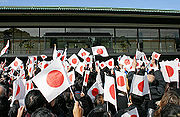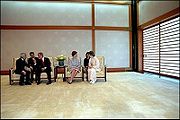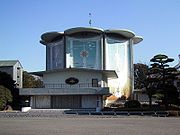
Kokyo
Encyclopedia


Emperor of Japan
The Emperor of Japan is, according to the 1947 Constitution of Japan, "the symbol of the state and of the unity of the people." He is a ceremonial figurehead under a form of constitutional monarchy and is head of the Japanese Imperial Family with functions as head of state. He is also the highest...
. It is a large park
Park
A park is a protected area, in its natural or semi-natural state, or planted, and set aside for human recreation and enjoyment, or for the protection of wildlife or natural habitats. It may consist of rocks, soil, water, flora and fauna and grass areas. Many parks are legally protected by...
-like area located in the Chiyoda
Chiyoda, Tokyo
is one of the 23 special wards in central Tokyo, Japan. In English, it is called Chiyoda ward. As of October 2007, the ward has an estimated population of 45,543 and a population density of 3,912 people per km², making it by far the least populated of the special wards...
area of Tokyo
Tokyo
, ; officially , is one of the 47 prefectures of Japan. Tokyo is the capital of Japan, the center of the Greater Tokyo Area, and the largest metropolitan area of Japan. It is the seat of the Japanese government and the Imperial Palace, and the home of the Japanese Imperial Family...
close to Tokyo Station
Tokyo Station
is a train station located in the Marunouchi business district of Chiyoda, Tokyo, Japan, near the Imperial Palace grounds and the Ginza commercial district....
and contains several buildings including the main palace
Palace
A palace is a grand residence, especially a royal residence or the home of a head of state or some other high-ranking dignitary, such as a bishop or archbishop. The word itself is derived from the Latin name Palātium, for Palatine Hill, one of the seven hills in Rome. In many parts of Europe, the...
' onMouseout='HidePop("83282")' href="/topics/Edo_Castle">Edo castle
Edo Castle
, also known as , is a flatland castle that was built in 1457 by Ōta Dōkan. It is located in Chiyoda in Tokyo, then known as Edo, Toshima District, Musashi Province. Tokugawa Ieyasu established the Tokugawa shogunate here. It was the residence of the shogun and location of the shogunate, and also...
.
The total area including the gardens is 7.41 sqkm. During the height of the 1980s Japanese property bubble
Japanese asset price bubble
The was an economic bubble in Japan from 1986 to 1991, in which real estate and stock prices were greatly inflated. The bubble's collapse lasted for more than a decade with stock prices initially bottoming in 2003, although they would descend even further amidst the global crisis in 2008. The...
, the palace grounds were valued by some as more than the value of all the real estate
Real estate
In general use, esp. North American, 'real estate' is taken to mean "Property consisting of land and the buildings on it, along with its natural resources such as crops, minerals, or water; immovable property of this nature; an interest vested in this; an item of real property; buildings or...
in the state of California
California
California is a state located on the West Coast of the United States. It is by far the most populous U.S. state, and the third-largest by land area...
.
Edo castle
After the capitulation of the Shogunate and the Meiji RestorationMeiji Restoration
The , also known as the Meiji Ishin, Revolution, Reform or Renewal, was a chain of events that restored imperial rule to Japan in 1868...
, the inhabitants, including the Shogun Tokugawa Yoshinobu
Tokugawa Yoshinobu
was the 15th and last shogun of the Tokugawa shogunate of Japan. He was part of a movement which aimed to reform the aging shogunate, but was ultimately unsuccessful...
, were required to vacate the premises of the Edo Castle
Edo Castle
, also known as , is a flatland castle that was built in 1457 by Ōta Dōkan. It is located in Chiyoda in Tokyo, then known as Edo, Toshima District, Musashi Province. Tokugawa Ieyasu established the Tokugawa shogunate here. It was the residence of the shogun and location of the shogunate, and also...
. In the second year of Meiji, on the 23rd day of the 10th month (1868), the emperor left Kyoto Imperial Palace for Tokyo. The Edo castle compound became the new imperial residence and was renamed in October 1868, and then renamed in 1869.
Previous fires already destroyed the Honmaru area containing the old donjon (which itself burned in the 1657 Meireki fire
Great Fire of Meireki
The , also known as the Furisode Fire, destroyed 60-70% of the Japanese capital city of Edo on March 2, 1657, this is the third year of the Meireki Imperial era...
). On the night of 5 May 1873, a fire consumed the Nishinomaru Palace (formerly the shogun's residence), and the new imperial was constructed on the site in 1888.
Old palace



Japanese architecture
' originated in prehistoric times with simple pit-houses and stores that were adapted to a hunter-gatherer population. Influence from Han Dynasty China via Korea saw the introduction of more complex grain stores and ceremonial burial chambers....
in their exterior appearance while the interiors were an eclectic mixture of Japanese and European elements fashionable in the 19th century. The ceilings of the grand chambers were coffered with Japanese elements; however, Western chairs, tables, and heavy curtains furnished the spaces. The floors of the public rooms had parquets or carpets while the residential spaces used the traditional tatami
Tatami
A is a type of mat used as a flooring material in traditional Japanese-style rooms. Traditionally made of rice straw to form the core , with a covering of woven soft rush straw, tatami are made in standard sizes, with the length exactly twice the width...
mats.
The main audience hall was the central part of the palace. It was the largest building in the compound and was where guests were received for public events. The floor space was more than 223 tsubo
Japanese units of measurement
' is the traditional Japanese system of measurement. The name shakkanhō originates from the name of two of the units, the shaku, a unit of length, and the kan, a mass measurement.The system is Chinese in origin...
or approximately 737.25 m² (881.7 sq yd). In the interior, the coffered ceiling was traditional Japanese-style, while the floor was parquetry. The roof was styled similarly to the Kyoto Imperial Palace, but was covered with copper plates (to make it fireproof) rather than Japanese cypress shingles.
In the late Taisho and early Showa eras, more buildings constructed of concrete were added, such as the headquarters of the Imperial Household Ministry and the Privy Council. These structures had a more modern appearance with only token Japanese elements.
From 1888 to 1948, the compound was called . On the night of 25 May 1945 most structures of the Imperial Palace were destroyed in the Allied fire-bombing raid. It was from the basement of the concrete library that Emperor Showa (Hirohito) declared the capitulation of Japan
Surrender of Japan
The surrender of Japan in 1945 brought hostilities of World War II to a close. By the end of July 1945, the Imperial Japanese Navy was incapable of conducting operations and an Allied invasion of Japan was imminent...
on 15 August 1945, ending World War II
World War II
World War II, or the Second World War , was a global conflict lasting from 1939 to 1945, involving most of the world's nations—including all of the great powers—eventually forming two opposing military alliances: the Allies and the Axis...
. Due to the large-scale destruction of the Meiji-era palace, a new main palace hall and residences were constructed on the western portion of the site in the 1960s. The area was renamed in 1948 while the eastern part was renamed and became a public park in 1968.
Interior images of the old Meiji-era palace that was destroyed during World War II
Present palace
The present Imperial Palace encompasses the retrenchments of the former Edo Castle. The modern palace for various imperial court functions is located in the old Nishinomaru, while the residence of the emperor and empress is located in the Fukiage Gardens.Except for Imperial Household Agency
Imperial Household Agency
The is a government agency of Japan in charge of the state matters concerning Japan's imperial family and also keeping the Privy Seal and the State Seal...
and the East Gardens, the palace is generally closed to the public. Each New Year
New Year
The New Year is the day that marks the time of the beginning of a new calendar year, and is the day on which the year count of the specific calendar used is incremented. For many cultures, the event is celebrated in some manner....
(January 2) and Emperor's Birthday
The Emperor's Birthday
is a national holiday in the Japanese calendar. It is currently celebrated on 23 December. The date is determined by the present Emperor's birthdate. Emperor Akihito was born on this date in 1933....
, the public is permitted to enter through the Nakamon (inner gate) where they gather in the Kyuden Totei Plaza in front of the Chowaden Hall. The imperial family appears on the balcony before the jubilant crowd and the emperor normally gives a short speech greeting and thanking the visitors and wishing them good health and blessings.
The old Honmaru, Ninomaru, and Sannomaru compounds now comprise the East Gardens, an area with public access containing administrative and other public buildings.
The Kitanomaru Park is located to the north and is the former northern enceinte
Enceinte
Enceinte , is a French term used technically in fortification for the inner ring of fortifications surrounding a town or a concentric castle....
of Edo Castle. It is a public park and is the site of Nippon Budokan Hall. To the south are the outer gardens of the Imperial Palace (Kokyogaien), which are also a public park.
Kyūden


The main buildings of the palace grounds , including the main palace, home of the liaison conference of the Imperial General Headquarters
Imperial General Headquarters
The as part of the Supreme War Council was established in 1893 to coordinate efforts between the Imperial Japanese Army and Imperial Japanese Navy during wartime...
, were severely damaged by the fire of May 1945.
Today's palace consists of multiple modern structures that are interconnected. The palace complex was finished in 1968 and was constructed of steel-framed reinforced concrete
Reinforced concrete
Reinforced concrete is concrete in which reinforcement bars , reinforcement grids, plates or fibers have been incorporated to strengthen the concrete in tension. It was invented by French gardener Joseph Monier in 1849 and patented in 1867. The term Ferro Concrete refers only to concrete that is...
structures produced domestically, with two stories above ground and one story below. The buildings of the Imperial Palace were constructed by the Takenaka Corporation
Takenaka Corporation
is the biggest architecture, engineering, and construction firm in Japan. Its headquarters is in Chūō-ku, Osaka, Osaka Prefecture.The company's website also claims it to be the oldest firm of that type anywhere in the world, since the demise of Kongō Gumi which was substantially older...
in a modernist style with clear Japanese architectural references such as the large, gabled hipped roof, columns and beams.
The complex consists of seven wings, including:
- Seiden State Function Hall
- Hōmeiden State Banquet Hall
- Chōwaden Reception HallChōwaden Reception HallThe is the largest building of the Tokyo Imperial Palace located in Tokyo, Japan. It is where the Japanese emperor and other members of the Japanese imperial family appear every new year and for the emperor's birthday...
- Rensui Dining Room
- Chigusa Chidori Drawing Room and
- The Emperor's work office
Halls include the Minami-Damari, Nami-no-Ma, multiple Kairo, Kita-Kurumayose, Kita-Damari, Syakkyo-no-Ma, Shunju-no-Ma, Seiden-Sugitoe (Kaede), Seiden-Sugitoe (Sakura), Take-no-Ma, Ume-no-Ma and Matsu-no-Ma.
The is used for both receiving state guests and holding official state ceremonies and functions. The Matsu-no-Ma (Pine Chamber) is the throne room, the emperor gives audiences to the prime minister here as well as to newly appointed or departing ambassadors.
Fukiage Garden
The Fukiage Garden has carried the name since the Edo period and is used as the residential area for the imperial family.The in the northern section was originally the residence of Emperor Showa and Empress Kōjun
Empress Kojun
' was empress consort of Emperor Hirohito of Japan. Born , she was the mother of the present Emperor .Her posthumous name is Kōjun, which means "fragrant purity"...
and was called the Fukiage Palace. After the Emperor's death in 1989, the palace was renamed the Fukiage Ōmiya Palace and was the residence of the Empress Dowager until her death in 2000.
The palace precincts include the Three Palace Sanctuaries
Three Palace Sanctuaries
The precincts of the Japanese Imperial Palace in Tokyo include structures known as the Three Palace Sanctuaries or Kyuchusanden . They are used in imperial religious ceremonies, including weddings and coronations. The three sanctuaries are:...
(Kyūchūsanden, 宮中三殿). Parts of the Imperial Regalia of Japan
Imperial Regalia of Japan
The , also known as the Three Sacred Treasures of Japan, consist of the sword Kusanagi , the mirror Yata no Kagami , and the jewel Yasakani no Magatama...
are kept here and the sanctuary plays a religious role in imperial coronations and weddings.
East Garden
The East Garden is where most of the administrative buildings for the palace are located and encompasses the former Honmaru and Ninomaru areas of Edo Castle, a total of 210000 m² (251,157.9 sq yd). Located on the grounds of the East Garden is the Imperial Tokagakudo Music Hall, the Music Department of the Board of Ceremonies of the Imperial Household, the Archives and Mausolea Department Imperial Household Agency, structures for the guards such as the Saineikan dojoDojo
A is a Japanese term which literally means "place of the way". Initially, dōjōs were adjunct to temples. The term can refer to a formal training place for any of the Japanese do arts but typically it is considered the formal gathering place for students of any Japanese martial arts style to...
, and the Museum of the Imperial Collections
Museum of the Imperial Collections
The Museum of the Imperial Collections is located on the grounds of the East Garden of Tokyo Imperial Palace. It showscases a changing exhibition of a part of the imperial household treasures...
.
Several structures that were added since the Meiji period were removed over time to allow construction of the East Garden. In 1932, the kuretake-ryō was built as a dormitory for imperial princesses, however this building was removed prior to the construction of the present gardens. Other buildings such as stables and housing were removed to create the East Garden in its present configuration.
Construction work began in 1961 with a new pond in the Ninomaru, as well as the repair and restoration of various keeps and structures from the Edo period. On 30 May 1963, the area was declared by the Japanese government a "Special Historic Relic" under the Cultural Properties Protection Law.
Tōkagakudō (Music Hall)

Empress Kojun
' was empress consort of Emperor Hirohito of Japan. Born , she was the mother of the present Emperor .Her posthumous name is Kōjun, which means "fragrant purity"...
on 6 March 1963. The ferro-concrete building covers a total area of 1254 m² (1,499.8 sq yd). The hall is octahedron-shaped and each of its eight outer walls is decorated with differently designed mosaic tiles. Construction began in August 1964 and was completed in February 1966.
Ninomaru Garden

Suwa no Chaya
The Suwa no Chaya is a teahouse that was located in the Fukiage Garden during the Edo period. It was moved to the Akasaka Detached Palace after the Meiji restoration but was reconstructed in its original location in 1912. It was moved to the present location with the construction of the East Garden.Kitanomaru
The Kitanomaru Park is located to the north and is the former northern enceinteEnceinte
Enceinte , is a French term used technically in fortification for the inner ring of fortifications surrounding a town or a concentric castle....
of Edo Castle. It is a public park and is the site of Nippon Budokan Hall.

